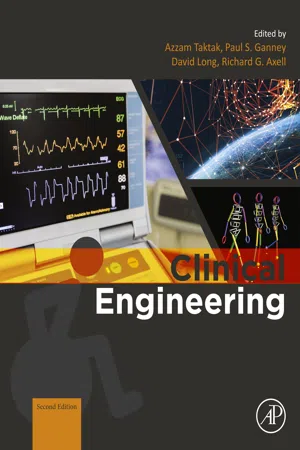
Clinical Engineering
A Handbook for Clinical and Biomedical Engineers
- 552 pages
- English
- ePUB (mobile friendly)
- Available on iOS & Android
Clinical Engineering
A Handbook for Clinical and Biomedical Engineers
About this book
Clinical Engineering: A Handbook for Clinical and Biomedical Engineers, Second Edition, helps professionals and students in clinical engineering successfully deploy medical technologies. The book provides a broad reference to the core elements of the subject, drawing from a range of experienced authors. In addition to engineering skills, clinical engineers must be able to work with both patients and a range of professional staff, including technicians, clinicians and equipment manufacturers. This book will not only help users keep up-to-date on the fast-moving scientific and medical research in the field, but also help them develop laboratory, design, workshop and management skills.The updated edition features the latest fundamentals of medical technology integration, patient safety, risk assessment and assistive technology.- Provides engineers in core medical disciplines and related fields with the skills and knowledge to successfully collaborate on the development of medical devices, via approved procedures and standards- Covers US and EU standards (FDA and MDD, respectively, plus related ISO requirements)- Includes information that is backed up with real-life clinical examples, case studies, and separate tutorials for training and class use- Completely updated to include new standards and regulations, as well as new case studies and illustrations
Frequently asked questions
- Essential is ideal for learners and professionals who enjoy exploring a wide range of subjects. Access the Essential Library with 800,000+ trusted titles and best-sellers across business, personal growth, and the humanities. Includes unlimited reading time and Standard Read Aloud voice.
- Complete: Perfect for advanced learners and researchers needing full, unrestricted access. Unlock 1.4M+ books across hundreds of subjects, including academic and specialized titles. The Complete Plan also includes advanced features like Premium Read Aloud and Research Assistant.
Please note we cannot support devices running on iOS 13 and Android 7 or earlier. Learn more about using the app.
Information
An introduction to clinical measurement
Abstract
Keywords
Introduction
Accuracy and precision
Table of contents
- Cover image
- Title page
- Table of Contents
- Copyright
- Contributors
- Foreword
- Preface
- Acknowledgement
- Section I. Professional practice
- Section II. Information technology & software engineering
- Section III. Clinical instrumentation & measurement
- Section IV. Rehabilitation engineering & assistive technology
- Index